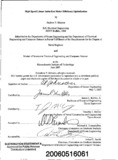High speed linear induction motor efficiency optimization
| dc.contributor.advisor | Kirtley, James L., Jr. | |
| dc.contributor.author | Johnson, Andrew Peter | |
| dc.date | June 2005 | |
| dc.date.accessioned | 2012-08-22T15:34:53Z | |
| dc.date.available | 2012-08-22T15:34:53Z | |
| dc.date.issued | 2005-06 | |
| dc.identifier.uri | https://hdl.handle.net/10945/11052 | |
| dc.description | CIVINS (Civilian Institutions) Thesis document | en_US |
| dc.description.abstract | One of the reasons linear motors, a technology nearly a century old, have not been adopted for a large number of linear motion applications is that they have historically had poor efficiencies. This has restricted the progress of linear motor development. The concept of a linear motor as a rotary motor cut and laid out flat with a conventional rotary motor control scheme as a design basis may not be the best way to design and control a high-speed linear motor. End effects and other geometry subtleties of a linear motor make it unique, and a means of optimizing efficiency with both the motor geometry and the motor control scheme will be analyzed to create a High-Speed Linear Induction Motor (LIM) with a higher efficiency than what is possible with conventional motors and controls. This thesis pursues the modeling of a short secondary type Double-Sided Linear Induction Motor (DSLIM) that is proposed for use as an Electromagnetic Aircraft Launch System (EMALS) aboard the CVN-2 1. Mathematical models for the prediction of effects that are peculiar to DSLIM are formulated, and their overall effects on the performance of the proposed machine are analyzed.;3 |a(cont.) These effects are used to generate a transient motor model, which is then driven by a motor controller that is specifically designed to the characteristics of the proposed DSLIM. Due to this DSLIM's role as a linear accelerator, the overall efficiency of the DSLIM will be judged by the kinetic energy of the launched projectile versus the total electric energy that the machine consumes. This thesis is meant to propose a maximum possible efficiency for a DSLIM in this type of role. | en_US |
| dc.description.uri | http://archive.org/details/highspeedlineari1094511052 | |
| dc.format.extent | 189 p.: ill. | en_US |
| dc.language.iso | en_US | |
| dc.publisher | Monterey California. Naval Postgraduate School | en_US |
| dc.rights | This publication is a work of the U.S. Government as defined in Title 17, United States Code, Section 101. Copyright protection is not available for this work in the United States. | en_US |
| dc.title | High speed linear induction motor efficiency optimization | en_US |
| dc.type | Thesis | en_US |
| dc.contributor.secondreader | McCoy, Timothy J. | |
| dc.contributor.corporate | Massachusetts Institute of Technology | |
| dc.contributor.department | Electrical Engineering and Computer Science | |
| dc.description.funder | CIVINS | en_US |
| dc.description.service | United States Navy | en_US |
| etd.thesisdegree.name | Naval Engineer | |
| etd.thesisdegree.name | M.S. of Electrical Engineering and Computer Science | en_US |
| etd.thesisdegree.level | Professional degree | |
| etd.thesisdegree.level | Masters | en_US |
| etd.thesisdegree.discipline | Electrical Engineering and Computer Science | en_US |
| etd.thesisdegree.grantor | Massachusetts Institute of Technology | en_US |
Files in this item
This item appears in the following Collection(s)
-
1. Thesis and Dissertation Collection, all items
Publicly releasable NPS Theses, Dissertations, MBA Professional Reports, Joint Applied Projects, Systems Engineering Project Reports and other NPS degree-earning written works. -
3. CIVINS (Civilian Institutions) Theses and Dissertations





